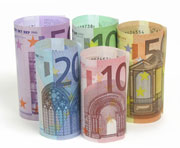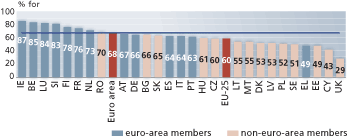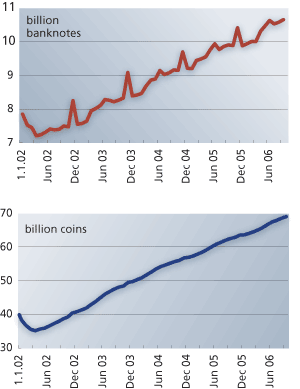Euro cash: five and familiar
 © Elena Aliaga |
The Commission’s recent Communication on five years of euro banknotes and coins presents the main developments with regard to euro notes and coins over the past five years and raises some policy issues with regard to the future evolution of the system. An accompanying Staff Working Paper provides more detailed information on the main issues raised in the Communication, including circulation figures, institutional and legal developments, changes in designs and the evolution of public opinion.
Euro banknotes and coins are now an established and familiar part of life for over 300 million people living in the euro area – and to some extent even for people outside it. And, indeed, there is a lot of euro cash around. The number of euro banknotes and coins in circulation has been climbing constantly over the past five years, reaching an estimated level of almost 11 billion euro banknotes worth around 590 billion euro, and over 68 billion euro coins worth almost 18 billion euro in October 2006 (see figure 1).
Figure 1: Total number of euro banknotes and coins in circulation
|
On the whole, cash is still by far the dominant means of payment for day-to-day purchases. Estimations suggest that cash payments still account for over 80% of the total number of transactions at retail level, although there are considerable variations between countries. Cash, therefore, will be with us for a good while yet.
Designs and denominations
The present series of notes and coins, designed by Robert Kalina of the Austrian central bank and Luc Luycx of Belgium’s national mint, has, in general, been widely accepted, with few challenges. A small number of countries, notably those used to having low-denomination notes in the past, expressed interest in introducing low-denomination euro banknotes (1-euro and 2-euro notes). After careful consideration, the European Central Bank’s (ECB) Governing Council decided not to pursue this request given, inter alia, the costs involved for the retail sector and the vending machine industry, as well as insufficient support from citizens in the euro area.
With regard to the coins, the 1-cent and 2-cent coins met with resistance in Finland and the Netherlands. In both countries, prices are rounded to the nearest 5 cents – in Finland by law, and in the Netherlands on a voluntary basis following a recommendation from the retail sector and consumer organisations. A majority of euro-area residents are satisfied with the current value structure.
In terms of value, the 500-euro note accounts for some 34% of the total value of notes in circulation. In quantitative terms, however, the 50-euro note is by far the most widely used (32% of all notes), followed by the 20-, 10- and 5-euro notes. For coins, the share in value relates directly to the face value of the coin, with the 2-euro coin accounting for the highest share in value, while in terms of quantity, the share is inversely related to the face value of the coin, with the 1-cent coin being the most numerous.
Although produced on a decentralised basis by the different national central banks (NCBs) of the euro area and authorised printing works, euro notes all look alike. However, it was decided that euro coins would have a common European side and a ‘national’ side which, with just a couple of provisos (e.g. the obligation to display the 12 European stars surrounding the design), was left to the country in question to design. There is a moratorium on changes to the national sides until the end of 2008. Since enlargement, it was agreed to produce a new common side for the five highest denominations of euro coins (10-, 20-, 50-cent and 1- and 2-euro), which depicts the European continent rather than the European Union of 15 Member States. Slovenia is the first to introduce the new common sides, but all euro-area countries will change over to the new design in the course of 2007 or 2008.
In addition, it was agreed that a number of commemorative coins could be issued to mark significant events (such as the Athens Olympic Games). To avoid confusion in the early years, commemorative coins were not allowed until 2004. And they are subject to certain restrictions: only 2-euro coins can be used for commemorative issues, and Member States may only issue one such coin per year in limited quantities. Since 2004, 21 commemorative coins have been issued and 15 are planned so far for 2007, including a joint commemorative coin to mark the 50th anniversary of the signing of the Treaty of Rome which, exceptionally, can be issued in addition to another ‘regular’ commemorative coin.
The number of national sides already exceeds 150 and will continue to increase with the enlargement of the euro area and future commemorative editions. For this reason, Member States agreed, in 2005, on a number of common guidelines (1) for future euro coin production so as to ensure continued coherence of the system. These should be followed for all new coin productions. In its Communication, the Commission announces that it will prepare the Council’s future decision on the moratorium on changes to the national sides by launching a euro-area survey in 2007 to collect people’s views and preferences.
Hard currency – euro cash outside the euro area
In a very short time, the euro has established itself as an international currency comparable to the US dollar and the Japanese yen. General confidence in the euro is high and euro banknotes, and to a lesser extent euro coins, are widely used outside the euro area. The ECB estimates that between 10% and 20% of the total value of euro banknotes in circulation is currently held outside the euro area.
In certain countries, the euro is being used as a regular means of payment, as in Monaco, San Marino and Vatican City (by monetary agreement) and in Andorra, Montenegro and Kosovo (on a unilateral basis). The euro is also used as a parallel currency for payment transactions and/or for savings purposes in many other countries and regions, particularly in neighbouring areas. In addition, there are many countries, also outside Europe, where the euro is accepted for purchases in tourist areas.
Defeating counterfeiting
The introduction of euro banknotes and coins as the official currency in 12 EU Member States, as well as in a number of third countries, meant that a concerted effort needed to be made to protect the currency against counterfeiting. While Member States continue to be primarily responsible for ensuring the protection of the euro, a transnational structure has been put in place to support anticounterfeiting efforts. Duties are shared between the European Central Bank (ECB), the European Commission/European Anti-Fraud Office (OLAF), Europol, Eurojust and Interpol.
In addition, a number of legal acts have been adopted at European level to increase the general level of protection and harmonise national legislation in this area. National analysis centres for counterfeit notes (NAC) and coins (CNAC) work closely with the ECB’s Counterfeit Analysis Centre (CAC) and the Commission’s/OLAF’s European Technical and Scientific Centre (ETSC) to identify, analyse and withdraw counterfeit notes from circulation. On the whole, the number of detected counterfeit notes has been stable since mid-2003, at approximately 600 000 per year. This is extremely low in relation to the number of notes in circulation, and is lower than the levels recorded for the US dollar.
Changing perceptions – thinking in euro?
Figure 2: Support for EMU and the euro  |
Support for EMU and the single currency has remained relatively stable since its introduction, according to the regular Eurobarometer surveys carried out for the European Commission. The latest surveys (autumn 2006) show that 68% of citizens in the euro area (60% in the EU as a whole) support the idea of EMU and the single currency (see figure 2). There are, however, some significant differences between countries, with the highest level of support for the euro in Ireland (87%) and the lowest in the UK (29%). When asked whether they considered the adoption of the euro advantageous for their country overall, 48% of respondents believed that the euro had brought advantages overall, (against 38% believing it to be disadvantageous). On the downside, this figure has been declining and, in addition, a large majority (93%) of respondents believe that the euro has added to price increases. This is a clear misperception, as annual price inflation in the euro area has never exceeded 2.4% since the introduction of the euro in 1999. This survey result is behind the Communication’s recommendation for renewed public information efforts on the euro.
So are we thinking in euro yet? Getting used to using the euro every day has been rather slow, but well over half of survey respondents (57%) say that they are now calculating in euro for day-to-day purchases. Larger purchases, such as cars and houses, however, still send most back to their old national currency. This suggests that the mental conversion to thinking in a new currency is a long process, but does not indicate any problem with the currency itself, which seems to have been very well accepted generally. It is encouraging that a clear majority of those surveyed consider themselves fully at ease using euro banknotes and coins.
(1) Commission Recommendation of 3.6.2005 on common guidelines for the national sides of euro circulation coins, OJ L186 of 18.7.2005, endorsed by the Ecofin Council of 7 June 2005.


